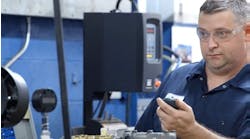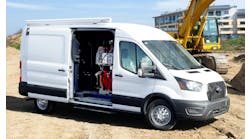This story appears in the October Aftermarket edition of TBB.
The consumer ecommerce boom across the country wouldn’t be possible without the trucking industry. But what about the trucking industry’s own ecommerce needs? To keep an order of dogfood and paper towels on schedule, the trucks must run. So to keep the supply chain from breaking—and to keep trucking from being the weakest link—aftermarket parts suppliers must up their game.
“What’s interesting about this industry is that it’s been slower to adopt ecommerce and other digital solutions,” Darren Taylor, FleetPride SVP of marketing and digital, said during a virtual media event on Oct. 12.
FleetPride has been beta testing a new ecommerce site for fleet customers to research and order parts for the past year. While FleetPride kept an active and comprehensive catalog on its website, visitors could only look up product information. Now fleets and other trucking customers can purchase items at FleetPride.com. There are more than 176,000 products available online for Classes 6-8 vehicles and heavy-duty trailers. Customers can search by part number, cross reference, year/make/model/engine type, or VIN.
The site, which just exited beta testing and is available across the U.S., allows fleet customers to securely store information on their vehicles in the “My Fleet” portal, setting them up to find parts in the future easily. Similarly, users can create favorite parts lists for the products they want to save. Customers can discover alternative parts and are offered additional parts to help complete the job. Additionally, newly redesigned search and checkout pages highlight critical information like ‘exact fit’ and real-time availability.
Enhancing its supply chain
Along with the new ecommerce offering, Taylor said that FleetPride is strengthening its supply chain by offering direct shipping options to customers from its five distribution centers and many branches across the U.S.
With an IBM-powered order management system and transportation management system, the site allows customers to accurately check the availability of real-time local inventory and select how they want to receive the product: through branch pickup, local delivery, or direct shipping. Now, even the most obscure product will be easily accessible and delivered when and where the customer needs it, the company noted.
“This was a game-changer,” Taylor said. “It’s a great example of listening to customers and transforming how we do business and just making it simple for them. This is not just about functionality; it's literally about how people do business—and how do we do business their way to get their trucks back on the road?”
Taylor said that the company focused on creating a user experience based on how heavy-duty fleet customers operate. “Whether it's a truck-down situation, or they're just replenishing routine stock items, we're constantly test driving new experiences with the customers in the field to learn how they use digital tools in real life, to help us accelerate the right things,” he said.
All orders and invoices can be managed through the site regardless of whether they’re placed online or in stores. Products ordered online can be returned to any FleetPride location. FleetPride also has an online chat and phone support available from its team of heavy-duty equipment experts and a help page. Customers can also send pictures from their mobile devices to help them confidently identify and order the right parts.
FleetPride CEO Mike Duffy credited the companies’ digital transformation strategy for making its new ecommerce offering possible. “We've developed a prioritized roadmap of opportunities to enhance decision-making, elevate the customer experience, and improve process productivity through digital,” he said during the media briefing. “Its success requires a comprehensive approach.”
That approach includes operation investments in planning software, warehouse management, transportation management, order management, and other digital and customer systems. “Our new integrated data platform, for example, will facilitate the aggregation and standardization of data, so data can be used as an asset to further improve the customer experience,” Duffy said.
These data systems, he said, set up FleetPride to continue to grow and compete in the future. And the aftermarket company’s planning systems “will provide more visibility, more transparency to our manufacturer partners,” Duffy said. “This, in turn, will improve the resiliency and responsiveness of the supply chain, help maximize in-stock availability on the broadest set of parts the industry has to offer. And ultimately, we'll be able to share that availability and visibility with our customers, 24/7 through our ecommerce platform.”‘Front-line’ impacts
The FleetPride leadership emphasized that upping their ecommerce game would enhance—not detract from—local storefront business.
“There's a lot of technology and data involved but, at the end of the day, this is all about people,” Taylor said. “When we set out to start the digital transformation, we took a holistic view intentionally. We actually train them how to understand how a customer does business, and this helps them get their jobs done, too. And we're building tools for both the customer and our internal teams—it makes everybody's life better.”
And that’s the benefit of the “omnichannel” experience—the local branches and the web platform work together “seamlessly,” Taylor continued, with local product experts joining an online search to guide the buyer in locating the correct part, and buyers locating parts in local stores and coming in to buy.
And the platform has also proved beneficial for new hires, Duffy added. “I’ve watched our folks on the front lines that have a ton of experience coaching the new employee to go to the ecommerce platform first, to help them with the visual aids, the 360-degree images, the part descriptions, the search feature which has great cross-referencing capability—and watching it play out in real time has been fascinating,” he said. “And messaging from our people on the front lines is that it's a tool we didn't have before to help new people on-board much faster in heavy duty.”
Similarly, the decision of whether to buy an existing local business or to build a new store is based on “the best use of capital,” Duffy noted, but he emphasized the “excitement” he’s found with the ownership and staff at FleetPride’s acquisitions.
“We're making the investments to compete not only now but for the future,” Duffy said. “They're excited to be part of that ecosystem, but they’re also excited about maintaining their local identity and presence. They play a huge part in their community, and they want to make sure that they continue to do so going forward.”
The leadership team also praised the relationship FleetPride has with its suppliers—even more critical during the ongoing supply chain challenges.
“We have diversified in some ways to make sure we've got redundancies and partnerships, all in an effort to keep customers’ trucks and trailers on the road and provide them with the solutions they need,” Harris said. “They continue to step up and help us partner to make sure that we've got the inventory in the right places when and where customers need it.”
Duffy pointed out that FleetPride has worked with those brand partners to shorten lead times, such as bypassing distribution centers and shipping parts directly to local branches.
“And we're geographically diversifying our supplier base, so we're not as reliant on China, for example,” Duffy said. “Given the challenges we see over the next six to 12 months, how do we build in redundancy, whether it's in Mexico or in Europe? Our teams are doing a great job—finding parts, keeping them on the shelf, and making sure that we have, if not the first choice, an alternative for our customers.”
And even competitors can cooperate if the customer benefits.
“Truck and trailer OEMs are competitors, naturally, in the local markets,” said Mike Harris, senior vice president of sales and branch operations. “But at the same time, you will also find tremendous opportunities where a local FleetPride may help or lean on their local OEM partner to solve customer problems. It's a two-way street and there's a mutual respect and support that exists in those local markets to do just that, with the customer in mind.”
Regarding electric vehicles, Duffy noted that the aftermarket is accustomed to adapting to and supporting new technologies.
“It’s too early to say which one will emerge as a winner, but we're positioning ourselves to be responsive to the needs of the market and to our customers,” he said. “That means we're talking to our suppliers every day; we talk to our national fleet and other customers, who may be on the leading edge of adoption of the new technologies; and we talk to the solution providers. We're making sure that we understand all the options and solutions.”











